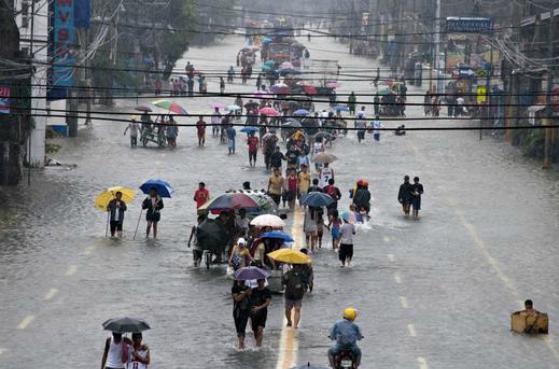A world warmer by 4°C would be one of unprecedented heat waves, severe drought and major floods in many regions, warns a new report by the World Bank ahead of the UN climate talks in Doha next week.
“Without further commitments and action to reduce greenhouse-gas emissions, the world is likely to warm by more than 3°C above the pre-industrial climate,” says the report.
“Even with the current mitigation commitments and pledges fully implemented, there is roughly a 20% likelihood of exceeding 4°C by 2100. If they are not met, a warming of 4°C could occur as early as the 2060s. Such a warming level and associated sea-level rise of 0.5 to 1 metre, or more, by 2100 would not be the end point: a further warming to levels over 6°C, with several meters of sea-level rise, would likely occur over the following centuries.”
At previous climate talks, governments have pledged to keep global warming within 2°C. However, their greenhouse-gas emission reduction commitments fall far short of matching the pledge. The current path of development is taking the world to far more dangerous levels of global warming, says the report written for the World Bank by the Potsdam Institute for Climate Impact Research and Climate Analytics.
Almost simultaneously, the United Nations Environment Programme (UNEP) has released a study that shows the gap between current emissions and the needed reductions is not only wide, but widening.
“Current pledges by governments indicate a 3-5°C temperature rise this century without fast action.” UNEP has come out with what it calls the Emissions Gap Report 2012, which says greenhouse-gas emissions levels are now around 14% above where they need to be in 2020.
In the World Bank report, the authors say no nation will be immune to the impacts of climate change. However, the distribution of impacts is likely to be inherently unequal and tilted against many of the world’s poorest regions, which have the least economic, institutional, scientific, and technical capacity to cope and adapt. For example:
• Even though absolute warming will be largest in high latitudes, the warming that will occur in the tropics is larger when compared to the historical range of temperature and extremes to which human and natural ecosystems have adapted and coped. The projected emergence of unprecedented high-temperature extremes in the tropics will consequently lead to significantly larger impacts on agriculture and ecosystems.
• Sea-level rise is likely to be 15-20% larger in the tropics than the global mean.
• Increases in tropical cyclone intensity are likely to be felt disproportionately in low-latitude regions.
• Aridity and drought are likely to increase substantially in many developing country regions located in tropical and subtropical areas.
A global mean temperature increase of 4°C approaches the difference between temperatures today and those of the last ice age, when much of central Europe and the northern United States were covered with kilometres of ice and global mean temperatures were about 4.5°C to 7°C lower. “And this magnitude of climate change – human induced – is occurring over a century, not millennia,” the authors point out.
Ocean acidity, water scarcity, smaller crop yields
Apart from a warmer world, it will be a world where the oceans are more acidic, as some of the excess carbon dioxide dissolves in water. This will mean the death of coral reefs, the nursery of almost all marine life. The sea level is likely to rise 0.5-1 metre by 2100 and more thereafter. And that is the global average. It will be 20% higher in the tropics. The report says coastal cities most vulnerable to this rise will be in Mozambique, Madagascar, Mexico, Venezuela, India, Bangladesh, Indonesia, the Philippines and Vietnam.
The authors quote some estimates that indicate a 4°C warming “would significantly exacerbate existing water scarcity in many regions, particularly northern and eastern Africa, the Middle East, and South Asia, while additional countries in Africa would be newly confronted with water scarcity on a national scale due to population growth.”
Even with a 2°C rise, monsoon-dominated river basins such as the Ganga and the Nile “are particularly vulnerable to changes in the seasonality of runoff, which may have large and adverse effects on water availability.” Average annual runoff is projected to increase by about 20% in both these basins. These changes approximately double in magnitude in a world 4°C warmer.
The report refers to recent studies that suggest a rapidly rising risk of crop yield reductions as the world warms.
“Large negative effects have been observed at high and extreme temperatures in several regions including India, Africa, the United States and Australia.”
All these “impacts on water availability, ecosystems, agriculture and human health could lead to large-scale displacement of populations and have adverse consequences for human security and economic and trade systems,” the report points out.
“The projected 4°C warming simply must not be allowed to occur – the heat must be turned down. Only early, cooperative, international actions can make that happen,” it concludes.



